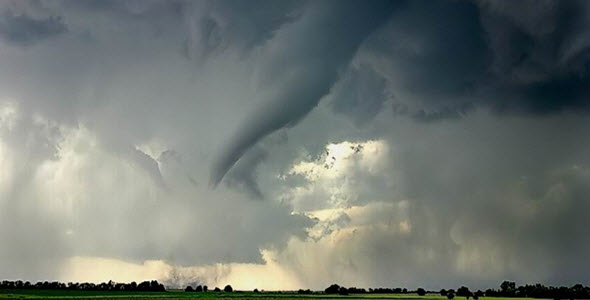
We’ve all heard the expression: “An ounce of prevention is worth a pound of cure.” And it’s just as true for disaster preparedness as it is for your personal health. While we can’t prevent weather events—such as tornadoes—from happening, we can prepare in case one strikes.
Do you have a fire escape plan for your home? Read our fire safety blog for tips!
According to the Federal Emergency Management Agency (FEMA), tornadoes are nature’s most violent storms, with winds reaching up to 300 miles per hour and damage paths in excess of one mile wide and 50 miles long. Tornadoes can also develop quickly with little to no warning, so we’ve compiled these tips to help you get ready before the storm hits.
1. Write it down.
It’s important to know the safe places in your home and at work ahead of time. Developing an emergency communication plan can help reduce confusion if you need to get to a safe place quickly. Make sure you have the plan accessible at all times and update it as needed. FEMA’s website has a variety of templates you can print and complete.
Consider these questions when writing the plan:
- How will I get emergency alerts and warnings?
- Where are safe locations and how will I get there? A basement works best, but if one isn’t available, aim for the center of a small interior room on the lowest level. Put as many walls as possible between you and the outside.
- If my cell phone, internet or landline doesn’t work, how will I call for help?
Keep in mind that many communities have text or email alerting systems for emergency notifications. To find out what alerts are available in your area, do an internet search with your town, city or county name and the word “alerts.”1
2. Build a kit.
A disaster supplies kit is simply a collection of basic items your household may need in the event of an emergency. Since you may have to evacuate at a moment’s notice, try to assemble the kit well in advance of an emergency and store it in the place where you’d take shelter during the storm.
Some of the items FEMA recommends having in the kit are:
- One gallon of water per person per day for at least three days
- At least a three-day supply of non-perishable food
- Battery-powered or hand crank radio and a flashlight with extra batteries
- First aid kit
3. Tidy the outside.
Most injuries stem from airborne debris, so do a sweep of your property to reduce the risk of damage from wind-borne objects.
Regular home maintenance should include:
- Replacing gravel and rock landscaping material with shredded bark
- Keeping trees and shrubbery trimmed
- Making sure structures, such as tool sheds and swing sets, are secured to the ground
- Cutting weak branches and trees that could fall on your house2
4. Consider a safe room.
Safe rooms are designed to provide a space where you and your family can seek refuge that offer a high level of protection. When safe rooms are built below ground level, they provide the greatest protection, but a safe room built in a first-floor interior room also can provide adequate protection.
You can build a safe room in one of several places in your home:
- Your basement
- On a concrete slab or garage floor
- An interior room on the first floor
5. Learn storm definitions.
Familiarize yourself with the different terms that identify a storm or a tornado risk:
- A Watch—A severe thunderstorm or tornado is possible. Remain alert for approaching storms. Watch the sky and listen to a radio or television for more information.
- A Warning—A severe thunderstorm or tornado has been sighted or indicated by a weather radar. You should take shelter immediately.3
6. Think about insurance.
Before storm season begins in your neck of the woods, review your insurance coverage with your independent agent.
Some key things to consider are:
- Having an up-to-date home inventory (and keeping it in a safe place). It may be difficult to remember all of your belongings that were lost in a storm, so make a list of everything you own and the rooms where things are located in case you need to file an insurance claim.
- Understanding the difference between actual cash value and replacement cost value, which would dictate how much money you could receive to rebuild your home and/or replace contents.
- Keeping your insurance policy number and your agent’s phone number in a safe place.4
What to do during the storm
If you happen to be placed under a storm warning, keep yourself as safe as possible and remember these steps:
- Seek shelter immediately in your designated safe place.
- Get under a sturdy table and use your arms to protect your head and neck.
- Don’t open your windows. It was once thought that this would help, but it actually will put you at risk of injury from breaking glass.
If you are unable to seek shelter:
- Take cover in a stationary vehicle. Put the seat belt on and cover your head with your arms and a blanket, coat or other cushion if possible.
- Do not get under an overpass or bridge. You are safer in a low, flat location.
- Never try to outrun a tornado in urban or congested areas in a car or truck.